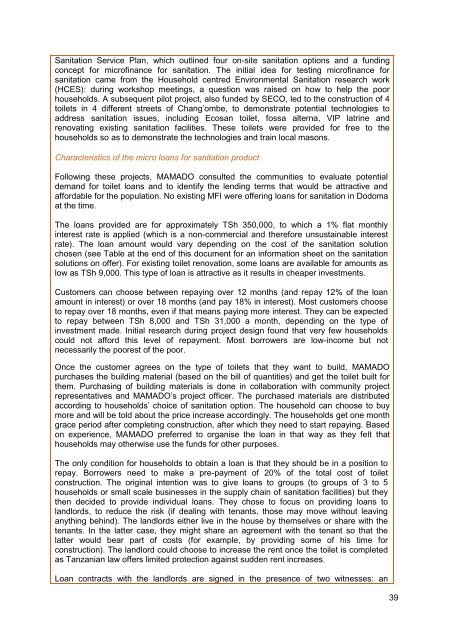REPORT__Evaluating_the_potential_of_microfinance_for_sanitation_in_Tanzania_May_2013
REPORT__Evaluating_the_potential_of_microfinance_for_sanitation_in_Tanzania_May_2013
REPORT__Evaluating_the_potential_of_microfinance_for_sanitation_in_Tanzania_May_2013
You also want an ePaper? Increase the reach of your titles
YUMPU automatically turns print PDFs into web optimized ePapers that Google loves.
Sanitation Service Plan, which outl<strong>in</strong>ed four on-site <strong>sanitation</strong> options and a fund<strong>in</strong>g<br />
concept <strong>for</strong> micr<strong>of</strong><strong>in</strong>ance <strong>for</strong> <strong>sanitation</strong>. The <strong>in</strong>itial idea <strong>for</strong> test<strong>in</strong>g micr<strong>of</strong><strong>in</strong>ance <strong>for</strong><br />
<strong>sanitation</strong> came from <strong>the</strong> Household centred Environmental Sanitation research work<br />
(HCES): dur<strong>in</strong>g workshop meet<strong>in</strong>gs, a question was raised on how to help <strong>the</strong> poor<br />
households. A subsequent pilot project, also funded by SECO, led to <strong>the</strong> construction <strong>of</strong> 4<br />
toilets <strong>in</strong> 4 different streets <strong>of</strong> Chang’ombe, to demonstrate <strong>potential</strong> technologies to<br />
address <strong>sanitation</strong> issues, <strong>in</strong>clud<strong>in</strong>g Ecosan toilet, fossa alterna, VIP latr<strong>in</strong>e and<br />
renovat<strong>in</strong>g exist<strong>in</strong>g <strong>sanitation</strong> facilities. These toilets were provided <strong>for</strong> free to <strong>the</strong><br />
households so as to demonstrate <strong>the</strong> technologies and tra<strong>in</strong> local masons.<br />
Characteristics <strong>of</strong> <strong>the</strong> micro loans <strong>for</strong> <strong>sanitation</strong> product<br />
Follow<strong>in</strong>g <strong>the</strong>se projects, MAMADO consulted <strong>the</strong> communities to evaluate <strong>potential</strong><br />
demand <strong>for</strong> toilet loans and to identify <strong>the</strong> lend<strong>in</strong>g terms that would be attractive and<br />
af<strong>for</strong>dable <strong>for</strong> <strong>the</strong> population. No exist<strong>in</strong>g MFI were <strong>of</strong>fer<strong>in</strong>g loans <strong>for</strong> <strong>sanitation</strong> <strong>in</strong> Dodoma<br />
at <strong>the</strong> time.<br />
The loans provided are <strong>for</strong> approximately TSh 350,000, to which a 1% flat monthly<br />
<strong>in</strong>terest rate is applied (which is a non-commercial and <strong>the</strong>re<strong>for</strong>e unsusta<strong>in</strong>able <strong>in</strong>terest<br />
rate). The loan amount would vary depend<strong>in</strong>g on <strong>the</strong> cost <strong>of</strong> <strong>the</strong> <strong>sanitation</strong> solution<br />
chosen (see Table at <strong>the</strong> end <strong>of</strong> this document <strong>for</strong> an <strong>in</strong><strong>for</strong>mation sheet on <strong>the</strong> <strong>sanitation</strong><br />
solutions on <strong>of</strong>fer). For exist<strong>in</strong>g toilet renovation, some loans are available <strong>for</strong> amounts as<br />
low as TSh 9,000. This type <strong>of</strong> loan is attractive as it results <strong>in</strong> cheaper <strong>in</strong>vestments.<br />
Customers can choose between repay<strong>in</strong>g over 12 months (and repay 12% <strong>of</strong> <strong>the</strong> loan<br />
amount <strong>in</strong> <strong>in</strong>terest) or over 18 months (and pay 18% <strong>in</strong> <strong>in</strong>terest). Most customers choose<br />
to repay over 18 months, even if that means pay<strong>in</strong>g more <strong>in</strong>terest. They can be expected<br />
to repay between TSh 8,000 and TSh 31,000 a month, depend<strong>in</strong>g on <strong>the</strong> type <strong>of</strong><br />
<strong>in</strong>vestment made. Initial research dur<strong>in</strong>g project design found that very few households<br />
could not af<strong>for</strong>d this level <strong>of</strong> repayment. Most borrowers are low-<strong>in</strong>come but not<br />
necessarily <strong>the</strong> poorest <strong>of</strong> <strong>the</strong> poor.<br />
Once <strong>the</strong> customer agrees on <strong>the</strong> type <strong>of</strong> toilets that <strong>the</strong>y want to build, MAMADO<br />
purchases <strong>the</strong> build<strong>in</strong>g material (based on <strong>the</strong> bill <strong>of</strong> quantities) and get <strong>the</strong> toilet built <strong>for</strong><br />
<strong>the</strong>m. Purchas<strong>in</strong>g <strong>of</strong> build<strong>in</strong>g materials is done <strong>in</strong> collaboration with community project<br />
representatives and MAMADO’s project <strong>of</strong>ficer. The purchased materials are distributed<br />
accord<strong>in</strong>g to households’ choice <strong>of</strong> <strong>sanitation</strong> option. The household can choose to buy<br />
more and will be told about <strong>the</strong> price <strong>in</strong>crease accord<strong>in</strong>gly. The households get one month<br />
grace period after complet<strong>in</strong>g construction, after which <strong>the</strong>y need to start repay<strong>in</strong>g. Based<br />
on experience, MAMADO preferred to organise <strong>the</strong> loan <strong>in</strong> that way as <strong>the</strong>y felt that<br />
households may o<strong>the</strong>rwise use <strong>the</strong> funds <strong>for</strong> o<strong>the</strong>r purposes.<br />
The only condition <strong>for</strong> households to obta<strong>in</strong> a loan is that <strong>the</strong>y should be <strong>in</strong> a position to<br />
repay. Borrowers need to make a pre-payment <strong>of</strong> 20% <strong>of</strong> <strong>the</strong> total cost <strong>of</strong> toilet<br />
construction. The orig<strong>in</strong>al <strong>in</strong>tention was to give loans to groups (to groups <strong>of</strong> 3 to 5<br />
households or small scale bus<strong>in</strong>esses <strong>in</strong> <strong>the</strong> supply cha<strong>in</strong> <strong>of</strong> <strong>sanitation</strong> facilities) but <strong>the</strong>y<br />
<strong>the</strong>n decided to provide <strong>in</strong>dividual loans. They chose to focus on provid<strong>in</strong>g loans to<br />
landlords, to reduce <strong>the</strong> risk (if deal<strong>in</strong>g with tenants, those may move without leav<strong>in</strong>g<br />
anyth<strong>in</strong>g beh<strong>in</strong>d). The landlords ei<strong>the</strong>r live <strong>in</strong> <strong>the</strong> house by <strong>the</strong>mselves or share with <strong>the</strong><br />
tenants. In <strong>the</strong> latter case, <strong>the</strong>y might share an agreement with <strong>the</strong> tenant so that <strong>the</strong><br />
latter would bear part <strong>of</strong> costs (<strong>for</strong> example, by provid<strong>in</strong>g some <strong>of</strong> his time <strong>for</strong><br />
construction). The landlord could choose to <strong>in</strong>crease <strong>the</strong> rent once <strong>the</strong> toilet is completed<br />
as <strong>Tanzania</strong>n law <strong>of</strong>fers limited protection aga<strong>in</strong>st sudden rent <strong>in</strong>creases.<br />
Loan contracts with <strong>the</strong> landlords are signed <strong>in</strong> <strong>the</strong> presence <strong>of</strong> two witnesses: an<br />
39


